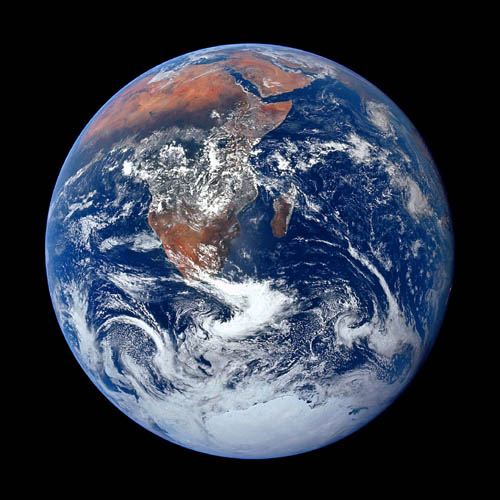
Features: Antactica, Africa, Madagascar and the Persian Gulf region
Description: Planet, third from the Sun (principal radiant body in the Solar system), an insignificant star somewhere in the Milky Way Galaxy
Distance: 28,000 miles
Exposure Date: December 7, 1972
Image Credit: NASA, JPL and the Apollo 17 crew.
ABOUT THIS IMAGE:
The
Blue Marble is a famous photograph of the Earth taken on December 7, 1972,
by the crew of the Apollo 17 spacecraft at a distance of about 45,000
kilometres (28,000 mi)
The picture is likely one of the most widely distributed photographic
images in existence. The image is one of the few to show a fully illuminated
Earth, as the astronauts had the Sun behind them when they took the image.
To the astronauts, Earth had the appearance of a glass marble (hence the
name). In the original photograph the South Pole was at the top. This
is because of the orientation in which the astronauts were traveling at
the time
The photograph was taken on December 7, 1972, at 5:39 a.m. EST (10:39 UTC), about 5 hours and 6 minutes after launch, and about 1 hour 54 minutes after the spacecraft left parking orbit around the Earth to begin its trajectory to the Moon. The time of Apollo 17's launch, 12:33 a.m. EST, meant that Africa was in daylight during the early hours of the spacecraft's flight. With the December solstice approaching, Antarctica also was illuminated.
The photograph's official NASA designation is AS17-148-22727. (The photograph AS17-148-22726, taken just before and nearly identical to 22727, also is used as a full-Earth image.) The photographer used a 70-millimeter Hasselblad camera with an 80-millimeter lens. NASA officially credits the image to the entire Apollo 17 crew – Eugene Cernan, Ronald Evans and Jack Schmitt – all of whom took photographic images during the mission with the on-board Hasselblad. After the mission, evidence showed that although the photograph could have been taken by any of the astronauts, Jack Schmitt probably took the famous image, although the official photographer still cannot be verified completely.
Apollo 17 was the last manned lunar mission. No humans since have been at a range where taking a whole-Earth photograph such as The Blue Marble would be possible.
The Blue Marble was the first clear image of a fully-illuminated Earth. Released during a surge in environmental activism during the 1970s, the image was seen by many as a depiction of Earth's frailty, vulnerability, and isolation amid the expanse of space. NASA archivist Mike Gentry has speculated that The Blue Marble is the most widely distributed image in human history
The picture originally was taken with South at the top of the image, but was rotated before it was distributed.
Here's the original NASA image caption:
AS17-148-22727 (7 Dec. 1972) --- This view of Earth was seen by the Apollo 17 crew as they traveled toward the moon on their NASA lunar landing mission. This outstanding trans-lunar coast photograph extends from the Mediterranean Sea area to the Antarctica south polar ice cap. This is the first time the Apollo trajectory made it possible to photograph the south polar ice cap. Note the heavy cloud cover in the Southern Hemisphere. Almost the entire coastline of Africa is clearly visible. The Arabian Peninsula can be seen at the northeastern edge of Africa. The large island off the coast of Africa is the Malagasy Republic. The Asian mainland is on the horizon toward the northeast. The Apollo 17 crew consisted of astronauts Eugene A. Cernan, mission commander; Ronald E. Evans, command module pilot; and Harrison H. Schmitt, lunar module pilot. While astronauts Cernan and Schmitt descended in the Lunar Module (LM) to explore the moon, astronaut Evans remained with the Command and Service Modules (CSM) in lunar orbit.